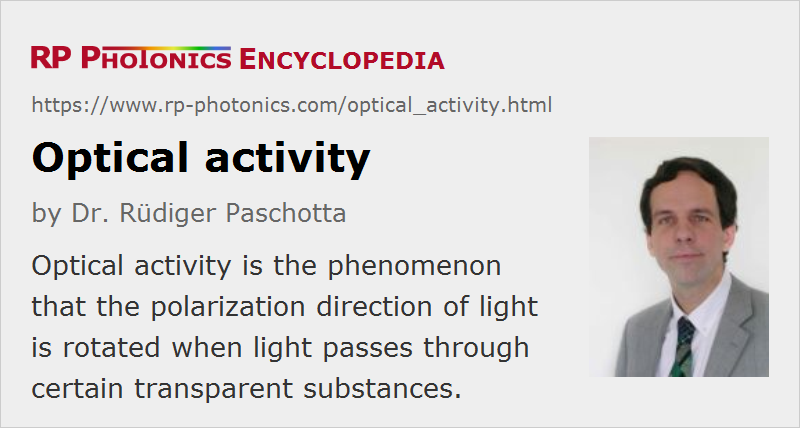Optical Activity
Definition: the phenomenon that the polarization direction of light is rotated when light passes through certain transparent substances
German: optische Aktivität
How to cite the article; suggest additional literature
Author: Dr. Rüdiger Paschotta
Optical activity is the phenomenon that the polarization direction of light is gradually rotated clockwise (dextrorotary) or anti-clockwise (levorotary) when light passes through certain transparent substances. That can occur when a substance contains chiral molecules and has different concentrations of the two enantiomers, i.e., the two versions of those molecules which are mirror images of each other, and rotated the polarization in opposite directions. An example for that situation is ordinary sugar (sucrose), which contains only one of the two possible enantiomers, the dextrorotary version. That striking asymmetry is related to the fact that biological organisms producing sugar have the same kind of asymmetry for a number of other types of molecules, and that the relative chirality of molecules can substantially influence their chemical reaction dynamics.
One can describe optical activity as a difference of the velocity of light (phase velocity) between two opposite rotation directions of circularly polarized light. Similarly, the phenomenon of different Raman scattering intensities for left and right polarized light is called Raman optical activity.
While optical activity is usually related to the presence of chiral molecules, as explained above, it can also be induced by a magnetic field in some substances; that is called the Faraday effect, which is exploited particularly in Faraday rotators and Faraday isolators.
Measurement of Optical Activity
The magnitude of optical activity can be measured with a polarimeter. While the basic measurement principle is rather old, these instruments have been substantially revised over the years and now allow for highly accurate measurements. There are even automated polarimeters which are for the combination of convenience, high speed and high accuracy.
Questions and Comments from Users
Here you can submit questions and comments. As far as they get accepted by the author, they will appear above this paragraph together with the author’s answer. The author will decide on acceptance based on certain criteria. Essentially, the issue must be of sufficiently broad interest.
Please do not enter personal data here; we would otherwise delete it soon. (See also our privacy declaration.) If you wish to receive personal feedback or consultancy from the author, please contact him e.g. via e-mail.
By submitting the information, you give your consent to the potential publication of your inputs on our website according to our rules. (If you later retract your consent, we will delete those inputs.) As your inputs are first reviewed by the author, they may be published with some delay.
See also: polarization of light, Faraday rotators, polarimeters
and other articles in the category general optics
 |



If you like this page, please share the link with your friends and colleagues, e.g. via social media:
These sharing buttons are implemented in a privacy-friendly way!